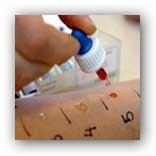|
There is evolving evidence that vitamin D
insufficiency may contribute to food allergy, but
findings vary between populations. Lower vitamin
D–binding protein (DBP) levels increase the
biological availability of serum vitamin D. Genetic
polymorphisms explain almost 80% of the variation in
binding protein levels.

Researchers sought to investigate whether
polymorphisms that lower the DBP could compensate
for adverse effects of low serum vitamin D on food
allergy risk.
From a population-based cohort study (n = 5276)
researchers investigated the association between
serum 25-hydroxyvitamin D3 levels and food allergy
at age 1 year (338 challenge-proven food-allergic
and 269 control participants) and age 2 years (55
participants with persistent and 50 participants
with resolved food allergy).
25-hydroxyvitamin D3 levels were measured using
liquid chromatography-tandem mass spectrometry and
adjusted for season of blood draw. Analyses were
stratified by genotype at rs7041 as a proxy marker
of DBP levels.
Low serum 25(OH)D3 level (≤50 nM/L) at age 1 years
was associated with food allergy, particularly among
infants with the GG genotype (odds ratio [OR], 6.0;
95% CI, 0.9-38.9) but not in those with GT/TT
genotypes (OR, 0.7; 95% CI, 0.2-2.0; P interaction =
.014).
Maternal antenatal vitamin D supplementation was
associated with less food allergy, particularly in
infants with the GT/TT genotype (OR, 0.10; 95% CI,
0.03-0.41).
Persistent vitamin D insufficiency increased the
likelihood of persistent food allergy (OR, 12.6; 95%
CI, 1.5-106.6), particularly in those with the GG
genotype.
Polymorphisms associated with lower DBP level
attenuated the association between low serum
25(OH)D3 level and food allergy, consistent with
greater vitamin D bioavailability in those with a
lower DBP level. This increases the biological
plausibility of a role for vitamin D in the
development of food allergy.
For more information
The Journal of Allergy and Clinical Immunology
Polymorphisms affecting vitamin D–binding protein
modify the relationship between serum vitamin D
(25[OH]D3) and food allergy
Link...
MDN |